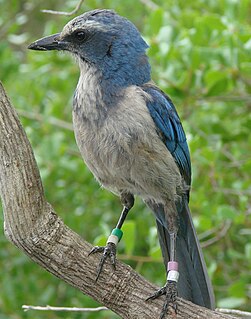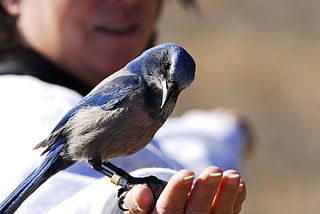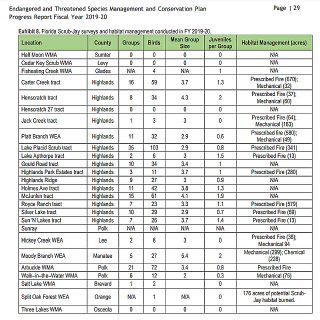Florida scrub jay
The endemic and endangered Florida scrub jay (Aphelocoma coerulescens) is one species of scrub jay native to North America. It is the only species of bird endemic to the U.S. state of Florida and one of only 15 species endemic to the continental United States.[1] Because of this, it is keenly sought by birders. It is known to have been present in Florida as a distinct species for at least 2 million years, and is possibly derived from the ancestors of Woodhouse's scrub jay.
It measures 23 to 28 cm (9.1 to 11.0 in) in length, and weighs from 66 to 92 g (2.3 to 3.2 oz), with an average 80.2 g (2.83 oz). The wingspan of the jay is 33–36 cm (13–14 in). It has a strong black bill, blue head and nape without a crest, a whitish forehead and supercilium, blue bib, blue wings, grayish underparts, gray back, long blue tail, black legs and feet.
Ecology
The Florida scrub jay is found only in Florida scrub habitat, an ecosystem that exists only in central Florida and in limited areas along the Atlantic coast, and is characterized by nutrient-poor soil, occasional drought, and frequent wildfires. Because of its being isolated from the mainland as an island ("Orange Island") 34 to 28 million years ago and somewhat harsh weather pattern, this habitat in isolation evolved to host, not only the Florida scrub jay endemic only to Florida but also a small assortment of very ancient specific plants, including sand pine, sand live oak, myrtle oak, Chapman's oak, sandhill oak, Florida rosemary and various other hardy plants such as Eastern prickly pear.
Florida scrub jays are omnivorous and eat a wide variety of acorns, seeds, peanuts, insects, tree frogs, turtles, snakes, lizards, and young mice. They have also been occasionally observed to eat other birds' eggs or nestlings, but this occurs rarely. They routinely cache thousands of acorns a year, burying them just beneath the surface. The acorns are typically buried in the fall and consumed during the winter and spring. Acorns that are forgotten or missed may germinate, making the Florida Scrub-Jay an effective agent for the dispersal of a variety of oak trees.
Scrub jays may also take silverware and other shiny objects in a manner similar to the American crow.
Reproduction
Florida scrub jays are one of the few cooperative breeding birds in North America. Fledglings remain in their parents' habitat for several years and help to rear young, watch for predators (such as short-tailed hawks or Accipiters), and defend territory against neighboring Florida scrub jay family groups. These families can range in size from 2 to 8.
After about 2 to 3 years, fledglings leave the group to form mating pairs of their own. Mating season ranges from March to June. Clutches usually contain about 3 to 4 eggs which are incubated in about 17 days. Fledging occurs in about 16 to 19 days. Fledglings can be distinguished from the adult birds due to the coloration of the feathers on their head, which are brown instead of blue. The brown feathers on the juvenile's head are slowly replaced by blue feathers as the bird matures into adulthood.
Conservation
Scrub habitat has dwindled considerably in the past several decades as Florida has continued to develop. Wildfire suppression also leads to the natural succession of large oaks and trees which changes the habitat. In recent years, environmental groups within the state have made a strong effort at preserving Florida's remaining scrub through controlled burns and even clearing out areas of large trees to increase the size of a scrub habitat. Because scrub habitat is typically "well-drained sites with low nutrient levels and periodic fires," the species is vulnerable to climate change. Oscar Scherer State Park near Sarasota has one of the larger habitats under state management.
The Florida scrub jay was officially listed as a threatened state species by Florida Fish and Wildlife Conservation Commission in 1975 and it was listed as a threatened federal species by the United States Fish and Wildlife Service in 1987.
According to Partners in Flight, there were estimated to be 4000 breeding pairs left in the wild. Despite the protections, the Florida scrub jay is still thought to be on the decline. Studies done in Brevard County, once the county with the greatest population of scrub jays, has noted declines of some 33% since the 1993 census alone.
Another attempt to conserve the bird is an ongoing campaign to name the Florida scrub jay as the new state bird of Florida. The main argument for changing the state bird is that the current state bird (viz. the northern mockingbird) is the state bird of several other states, while the scrub jay is exclusive to Florida.
In recent years there has been some debate about whether or not the Florida scrub jay should be officially listed as an Endangered Species because of the loss of homes. However, environmentalists hope that current conservation efforts should help the species population to at least stabilize.
On the other hand, the IUCN classifies this species as vulnerable to extinction. In 2004, the population was declining and no more than 10 subpopulations were known. Both the number of adult birds as well as amount and quality of habitat were in decline, and local subpopulations were in danger of disappearing altogether. About 8000 mature birds were believed to exist—with no more than 1000 in any one subpopulation—and population numbers had dropped by about 10% over the last decade or so.
A long-term and ongoing study of the Florida scrub jay has been taking place at the Archbold Biological Station at Lake Placid.
Dangers of human feeding
An inquisitive and intelligent species, the most striking attribute of the Florida scrub jay's behavior is its remarkable tameness. As such, scrub jays willingly take food from human hands.
Unfortunately, this tameness is dangerous to the well-being of the species. Florida scrub jays that are fed by humans will reproduce earlier in the year than those that are not. However, fledgling scrub jays feed primarily on caterpillars present in the late spring and summer; if they hatch too early in the year when the caterpillars are not available, this can lead to their malnutrition or starvation.
Another potential danger of feeding Florida scrub jays occurs when people feed them near a road, as one major cause of death for scrub jays in urban areas is collision with vehicles. Since humans build subdivisions, railroads, and highways on the highest and driest ground, where Florida scrub jays like to live, this removal of habitats, along with the introduction of pets, especially cats not on a leash, has devastated scrub jay populations. In the last 100 years, 90% of the bird's population has been lost.
Florida Endangered Species Report 2020
The following endangered Florida scrub-jay information is from the Florida Fish and Wildlife Conservation Commission (FWC) 2020 Florida Endangered Species Progress Report Pages 26-29[2]
Florida Scrub-Jay
The Florida Scrub-Jay is a Federally Threatened species that is endemic to Florida. Three-quarters of remaining scrubby habitats are protected through land under public or private ownership that is dedicated for conservation. Despite this, Florida Scrub-Jay numbers have continued to decline on conservation lands largely due to habitat degradation caused by decades of fire suppression and inadequate habitat management. Conserving this species requires the efforts of multiple local, State, and Federal agencies and non-governmental organizations and private landowners. Staff assist these efforts by facilitating communication among partners through regional scrub working groups and by engaging with the public through outreach.
Public and Partner Engagement
In FY 2019-2020, FWC staff helped organize the tenth annual Florida Scrub-Jay Festival to raise awareness about the Florida Scrub-Jay and its unique habitat. Oscar Scherer State Park hosted the event in January, coupling it with a 5K run. Approximately 540 people attended. Staff are currently involved in planning the next Scrub-Jay Festival, which will be held at Jonathon Dickinson State Park in 2021. Staff usually facilitate communication and information exchange among partners via regional working groups focused on conservation of Scrub-Jays and their habitat. Although three scrub working groups were organized for March – May, all were canceled due to COVID19. Staff continued to provide technical assistance for stakeholders regarding habitat management, development planning, and general inquiries. Staff also participated in Jay Watch, a citizen-science program organized by Audubon Florida that collects information annually on Scrub-Jays on public lands and educates the public about Scrub-Jays.
Translocations
In 2017, FWC initiated a partnership with the US Forest Service, Florida Forest Service, and Florida Park Service to conduct experimental translocations of Scrub-Jays from Ocala National Forest (Marion County) to other public lands. The objectives of this project are to evaluate the effectiveness of different translocation methods and evaluate the impact of translocation on donor populations. In FY 2019-20, two Scrub-Jay family groups comprising five individuals were translocated to Jonathan Dickinson State Park (Martin County). Eight non-breeding “helper” Scrub-Jays and four nonbreeding “helper” Scrub-Jays were translocated to Rock Springs Run Reserve State Park (Orange and Seminole counties) and Seminole State Forest (Lake County), respectively. Persistence and survival at recipient sites in the past two years have been lower for translocated helpers than for birds translocated with their family groups. One of the four birds translocated to Seminole State Forest in January 2020 moved to Rock Springs Run Reserve State Park. Birds translocated with an immediate release (opposed to a delayed release with an acclimation period), were equally or more likely to settle near their release site. FWC is also partnering with the University of Florida to study the behavior of resident Scrub-Jays at the donor site after removals for translocation. A statewide translocation project is planned.
Surveys
Volunteers from the Jay Watch Program conduct surveys each summer. Although over 130 jays have been color banded on Half Moon WMA (Sumter County) since 2001, banding has been discontinued due to the decline in jay numbers. No juveniles have been found for the past 5 years. There were no Scrub-Jays during the 2020 survey. The last year a Scrub-Jay was located is 2018. Habitat management is focused on prescribed burning, roller chopping palmetto; and mowing, cutting, or applying herbicide to overgrown oak trees. Half Moon WMA harbors approximately 500 acres of potential jay habitat, consisting of scrubby and mesic flatwoods. Habitat management will continue with palmetto reduction through roller chopping, increasing open ground, and cutting overgrown oaks in and surrounding potential habitat.
The Arbuckle WMA and the Walk-In-The-Water WMA (both in Polk County) are part of the Lake Wales Ridge Sate Forest and encompass nearly 20,000 acres of various habitat types, including scrub and sandhill. In FY 2019-20, the number of groups (21) increased, but the total number of birds (72), mean group size (3.4) and the number of juveniles per group (0.8) all decreased over the previous year in Arbuckle WMA (Exhibit 8). In FY 2019-20, the total number of groups (6), total number of Scrub-Jays (12), the mean group size (2.0) and the number of juveniles per group (0.3) all decreased from the previous year in Walk-In-The-Water WMA (Exhibit 8). The lead management agency, Florida Department of Agriculture and Consumer Services, conducted habitat management on both WMAs, including prescribed fire on Arbuckle WMA and 75 acres of mechanical treatment on Walk-In-TheWater WMA (Exhibit 8). Lake Wales Ridge WEA (Highlands and Polk counties) consist of 20 tracts with 14 retaining Scrub-Jay groups, which are monitored by FWC, Archbold Biological Station, and Jay Watch. Group numbers increased at the Lake Placid Scrub, McJunkin, Holmes Ave, Carter Creek, Jack Creek, Henscratch, and Gould Rd tracts (Exhibit 8). Group numbers remained the same at the Silver Lake tract (Exhibit 8). The Sunray tract was not surveyed (Exhibit 8). Group numbers decreased at the Royce Ranch, Lake Apthorpe, Sun ‘N Lakes, Highlands Ridge, and Highlands Park Estates tracts (Exhibit 8). Controlled burns occurred on 2,066 acres and 255 acres were mechanically treated (Exhibit 8)
In FY 2019-20, surveys were conducted at Fisheating Creek WMA (Glades County) over 3 days with four jays observed (Exhibit 8). At least five jays were observed foraging on December 27, 2019 while staff were conducting reptile and amphibian coverboard surveys. Surveys at Salt Lake WMA (Brevard County) indicated a decline in the number of Scrub-Jay groups. In FY19-20 a survey was conducted where one group was recorded consisting of two banded adults (Exhibit 8). In FY19-20, a Spring Scrub-Jay survey was conducted documenting one Scrub-Jay at Split Oak Forest WEA (Orange County; Exhibit 8). Staff conducted management in potential Scrub-Jay habitat, including 176 acres of prescribed fire (Exhibit 8). In FY19-20, a Spring Scrub-Jay survey was conducted at Three Lakes WMA (Osceola County), but no Scrub-Jays were detected during the survey (Exhibit 8). Annual monitoring of Florida Scrub-Jays in FY 2019-20 occurred at three mitigation parks in the southwest region. Scrub-Jay monitoring at Hickey Creek WEA (Lee County) was down one group from FY 2018-19 as the newly formed territory did not persist (Exhibit 8). No juvenile was confirmed after the nesting season. Additional birds were occasionally observed just off the site in a residential area. Management actions included 37 acres of prescribed burning, 94 acres of mechanical treatment, and 67 acres of chemical treatment (Exhibit 8). The Platt Branch WEA (Highlands County) was monitored by FWC and both group numbers and individuals expanded in FY 2019-20 (Exhibit 8). Management efforts included burning 580 acres and mechanically treating 49 acres to improve habitat (Exhibit 8). The Moody Branch WEA (Manatee County) is monitored by both FWC staff and JayWatch volunteers. The group number was consistent with the previous year (Exhibit 8) and in FY 2019- 20 mechanical treatments were conducted on 299 acres and 228 acres were chemically treated (Exhibit 8).







